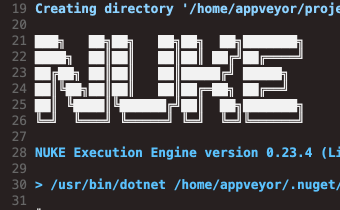Whether you need to throw together a quick console app or scaffold an enterprise solution, it can be a real time suck just creating, naming and referencing projects. Setting up boilerplate logging, dependency injection, data access, messaging, gulp and other tools can send you hunting through previous work to copy and paste code. Let’s put an end to all that once and for all with less than an hour of work using dotnet new templating! The advantages of this approach include:
- Use a tool that's already on any development machine
- No new templating language to learn
- Use runnable Solution/Project/Files as templates
- Bundle many templates into a single distributable package
- Access templates from any machine with a single command
Let's get started:
Our goal is to be able to easily create and distribute custom templates to any machine; so let’s first take a look at what templates already exist on our machine:
> dotnet new -l
Templates Short Name Language Tags ---------------------------------------------------------------------------------------------------------------------------------- Console Application console [C#], F#, VB Common/Console Class library classlib [C#], F#, VB Common/Library
You should see a list of templates longer but similar to above. Our custom templates will show up in this list when we’re done. To create a new project from the template named console in the list above we can type:
> dotnet new console -n SampleFromTemplate
This will create a new folder with a console app named SampleFromTemplate. It’s ready to go with nuget packages restored and the namespaces set to SampleFromTemplate.
SampleFromTemplate
└─── SampleFromTemplate.csproj
└─── Program.cs
└─── /obj
To begin creating custom templates with dotnet new simply create a normal project or solution (or just one or more files) that represents your boilerplate code for a given scenario. That’s almost all there is to it. Adding a configuration file to setup some metadata and behavior will result in a resuable template. The template folder structure for a simple console app project will look something like this:
└───mycustomtemplate
└─── Templating.ConsoleApp.csproj
└─── Program.cs
└─── /.template_config
└─── template.json
- Start with any existing project and from the project root folder
> mkdir .template_config
.template_config folder. Otherwise you can leave it up to the user to specify on the command line using the -o option.
/src /test /doc /build /migrations. For now you will need to place a file named -.- inside the folder otherwise the empty folder will be ignored in the output
- Add a
template.jsonto the.template_configfolder
{
"$schema": "http://json.schemastore.org/template",
"author": "Camron Frenzel",
"classifications": [ "cfrenzel", "core", "console" ],
"tags": {
"language": "C#"
},
"identity": "demo.console",
"name": "demo.console_2.2",
"shortName": "dm-console-2.2",
"sourceName": "Templating",
"sources": [
{
"modifiers": [
{ "exclude": [ ".vs/**", ".template_config/**" ] }
]
}
],
}
identitya unique name for the templatenamefor display purposesshortNamewhat users will type to specify your templatesources -> exclude:This is a little trick to keep some unwanted files out of the template-
sourceNamethe name in the source tree to replace with the user specified name (using-nor--name).sourceNameis important!.dotnet newwill replace all the folders/files/namespaces/etc.. containing this name with whatever the user passes in on the command line. For example: If I’m using a convention such as└─── Templating.sln └─── /src └─── /Templating.ConsoleApp └─── Templating.ConsoleApp.csproj └─── /Templating.Domain └─── Templating.Domain.csproj └─── /Templating.Application └─── Templating.Application.csprojThen passing in
-n Demowill produce:> dotnet new demo.console_2.2 -n Demo└─── Demo.sln └─── /src └─── /Demo.ConsoleApp └─── Demo.ConsoleApp.csproj └─── /Demo.Domain └─── Demo.Domain.csproj └─── /Demo.Application └─── Demo.Application.csproj namespaces: Templating.ConsoleApp -> Demo.ConsoleApp - At this point you should be comfortable with these concepts
- a template is a normal solution/project/file
- add a
.template_configfolder with atemplate.configfile in it to configure a template - the user will pass in a –name MyApp to the template that will replace the configured
sourceNametext in all folders/solutions/projects/namespaces
"symbols": {
"skipRestore": {
"type": "parameter",
"datatype": "bool",
"description": "If specified, skips the automatic restore of the project on create.",
"defaultValue": "false"
}
},
"postActions": [
{
"condition": "(!skipRestore)",
"description": "Restore NuGet packages required by this project.",
"manualInstructions": [
{ "text": "Run 'dotnet restore'" }
],
"actionId": "210D431B-A78B-4D2F-B762-4ED3E3EA9025",
"continueOnError": true
}
]
"primaryOutputs": [
{ "path": "SolutionName.ConsoleApp/SolutionName.ConsoleApp.csproj" }
],
"postActions": [
{
"description": "Add project to solution",
"manualInstructions": [],
"primaryOutputIndexes": "0",
"actionId": "D396686C-DE0E-4DE6-906D-291CD29FC5DE",
"continueOnError": true
}
]
https://github.com/dotnet/templating/issues/1489
If you haven’t created your own template at this point you can follow along by downloading a console app template with logging/DI/configuration here
Installing a template
We could install our template locally from the template root folder.
dotnet new -i .
List the installed templates and you should see your template listed
dotnet new -l
You can use it by passing in it’s shortName and provide a name
> dotnet new {shortname} -n DemoApp
To remove your template
dotnet new -u
You should see your template along with an Uninstall command:. This command will come in handy as things can get confusing when managing multiple versions of your templates and installing them from different sources.
dotnet new -u C:\temptemplate\temptemplate
Not bad, but the workflow leaves a lot to be desired. It would be a pain to manage even a modest number of templates using this method.
Packaging templates
The dotnet new templating tool supports installing templates from nuget packages locally or in remote repositories. Multiple templates can be included in a single package, which allows adding and removing collections of templates from the internet with a single command.
Packaging templates took some tinkering for me; so let’s get straight to what works by creating a special project that will help us get all of our templates into a single package. The structure of our multi-template solution will look like this:
└─── /my-dotnet-templates
└─── my-dotnet-templates.sln
└─── /templates
└─── Directory.Build.props //metadata for package
└─── templates.csproj
└─── /ConsoleApp //template 1
└─── Templating.sln
└─── /.template_config
└───template.json
└─── /Templating.ConsoleApp
└─── Templating.ConsoleApp.csproj
└─── /WebApp //template 2
└─── Templating.sln
└─── /.template_config
└───template.json
└─── /Templating.WebbApp
└─── Templating.WebApp.csproj
The idea is that you have a solution with a /templates folder and a special project: template.csproj that will aid in building the multi-template package. Within the
/templates folder you will have a folder for each template. The folder for each template should contain everything you need to develop and test the template. You won’t be able to run the template from our special templates.csproj so it’s nice to have a seperate solution for running/editing each template.
- You can start by creating
templates.csprojas a console app. Open the .csproj file and edit it to look like this:
<Project Sdk="Microsoft.NET.Sdk">
<PropertyGroup>
<PackageType>Template</PackageType>
<TargetFramework>netcoreapp2.2</TargetFramework>
<PackageId>cfrenzel-dotnet-new-templates-2.2</PackageId>
<Title>cfrenzel dotnet-new-templates</Title>
<IncludeContentInPack>true</IncludeContentInPack>
<IncludeBuildOutput>false</IncludeBuildOutput>
<ContentTargetFolders>content</ContentTargetFolders>
</PropertyGroup>
<ItemGroup>
<Content Include="ConsoleApp\**" Exclude="ConsoleApp\SolutionName.sln;ConsoleApp\**\bin\**;ConsoleApp\**\obj\**;ConsoleApp\**\.vs\**" />
<Content Include="EFCore.MigrationProjects\**" Exclude="EFCore.MigrationProjects\**\bin\**;EFCore.MigrationProjects\**\obj\**;EFCore.MigrationProjects\**\.vs\**" />
<Content Include="Solution\**" Exclude="Solution\**\bin\**;Solution\**\obj\**;Solution\**\.vs\**" />
<Compile Remove="**\*" />
</ItemGroup>
</Project>
<PackageType>Template</PackageType>- set special package type for project- For each template in our package we are adding a
<Content>tag that specifies which files to include and exclude<Content Include="ConsoleApp\**"- include everything from our /ConsoleApp folderExclude="ConsoleApp\Templating.sln;ConsoleApp\**\bin\**;ConsoleApp\**\obj\**;ConsoleApp\**\.vs\**" />- exclude the solution file and bin/obj folders
-
<Compile Remove="**\*" />- we’re not interested in the output of the compiled project - We can specify metadata for the package in
Directory.Build.props
<Project>
<PropertyGroup>
<Authors>Camron Frenzel</Authors>
<RepositoryUrl>https://github.com/cfrenzel/dotnet-new-templates-2.2.git</RepositoryUrl>
<PackageProjectUrl>https://github.com/cfrenzel/dotnet-new-templates-2.2</PackageProjectUrl>
<Description>dotnet new templates for core 2.2</Description>
<PackageTags>template dotnet console migration web</PackageTags>
<PackageLicense></PackageLicense>
<Version>1.0.0</Version>
</PropertyGroup>
</Project>
- Now we can create our nuget package using
templates.csproj
dotnet pack .\templates\templates.csproj -o .\artifacts\ --no-build
And install all of our templates locally from our .nupkg file
dotnet new -i .\artifacts\cfrenzel-dotnet-new-templates-2.2.1.0.0
Find the Uninstall command: to remove
dotnet new -u
Publish package for access online
You can host your template .nupkg for free using my MyGet or make it official/perminent using NuGet.org. This can be as simple as typing
dotnet nuget push artifacts\**\*.nupkg -s "https://www.myget.org/F/{youraccount}/api/v2/package" -k {yourkey}
Then installing your templates from anywhere using
dotnet new --install {yourpackagename} --nuget-source https://www.myget.org/F/{youraccount}/api/v3/index.json
-Since we’re pretty much one configuration file away from free continuous build and deployment, let’s setup AppVeyor to build and publish our template package every time we commit a change to the source code.
- Save you code to Github or wherever
- Add an
appveyor.ymlto build and publish template package to MyGet
version: '1.{build}'
image: Visual Studio 2019
environment:
MyGetApiKey:
secure: 56nW3KcP4naYX9mlsVEIKLj5xPdfmpt6lMALR6wQmorRQOaoUOtlwMZ2V0BtGTAM
NugetApiKey:
secure: /54XAunyBETRa1Fp/qSrwvebSnTAcHDO2OVZ+exMtQtOtrBzHKvp4RC1AB8RD2PQ
pull_requests:
do_not_increment_build_number: true
branches:
only:
- master
nuget:
disable_publish_on_pr: true
test: off
build_script:
- dotnet restore
- dotnet pack .\templates\templates.csproj -o .\artifacts\ --no-build
deploy_script:
- ps: dotnet nuget push artifacts\**\*.nupkg -s "https://www.myget.org/F/cfrenzel-ci/api/v2/package" -k $env:MyGetApiKey
After you link your AppVeyor project to your source repo, your template .nupkg will be updated in MyGet/Nuget every time you commit to master.
Final Thoughts
Though templating with dotnet new has some more powerful features including:
- conditional logic
- custom parameters
- post actions
- multi-language
- see docs - template.json
I really appreciate the simplicity of the tool. You simply use what you’re already doing to make doing what you’re already doing faster. No need to learn a new complex template language.
full source code for this post.
 Publishing .NET Core NuGet Packages with Nuke and AppVeyor
Publishing .NET Core NuGet Packages with Nuke and AppVeyor